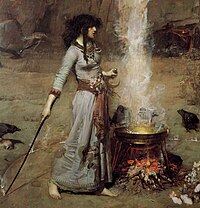This article has multiple issues. Please help improve it or discuss these issues on the talk page. (Learn how and when to remove these template messages)
|
| Part of a series on |
| Witchcraft |
|---|
 |
Witchcraft in Latin America, known in Spanish as brujería (pronounced [bɾuxeɾˈi.a]),[1][2] is a complex blend of indigenous, African, and European influences. Indigenous cultures had spiritual practices centered around nature and healing, while the arrival of Africans brought syncretic religions like Santería and Candomblé. European witchcraft beliefs merged with local traditions during colonization, contributing to the region's magical tapestry. Practices vary across countries, with accusations historically intertwined with social dynamics. A male practitioner is called a brujo, a female practitioner is a bruja.[3]
When Franciscan friars from New Spain arrived in the Americas in 1524, they introduced Diabolism—belief in the Christian Devil—to the Indigenous peoples of the Americas.[4] Bartolomé de las Casas believed that human sacrifice was not diabolic, in fact far off from it, and was a natural result of religious expression.[4] Mexican Indians gladly took in the belief of Diabolism and still managed to keep their belief in creator-destroyer deities.[5]
Witchcraft was an important part of the social and cultural history of late-Colonial Mexico, during the Mexican Inquisition. The presence of the witch is a constant in the ethnographic history of colonial Brazil, especially during the several denunciations and confessions given to the Congregation for the Doctrine of the Faith of Bahia (1591–1593), Pernambuco and Paraíba (1593–1595).[6]
Yet, as anthropologist Ruth Behar writes, witchcraft, not only in Mexico but in Latin America in general, was a "conjecture of sexuality, witchcraft, and religion, in which Spanish, indigenous, and African cultures converged."[7] Furthermore, witchcraft in Mexico generally required an interethnic and interclass network of witches.[8] According to anthropology professor Laura Lewis, witchcraft in colonial Mexico ultimately represented an "affirmation of hegemony" for women, Indians, and especially Indian women over their white male counterparts as a result of the casta system.[9]
- ^ María Herrera-Sobek (2012). Celebrating Latino Folklore: An Encyclopedia of Cultural Traditions. ABC-CLIO. p. 174. ISBN 978-0-313-34339-1.
- ^ "brujería". Pop Culture Dictionary, by Dictionary.com. Retrieved 2020-02-24.
- ^ Herrera-Sobek (2012), p. 175.
- ^ a b "Diabolism in the New World". ABCCLIO. 2005. Archived from the original on July 18, 2021. Retrieved February 10, 2013.
- ^ Young, Eric Van; Cervantes, Fernando; Mills, Kenneth (November 1996). "The Devil in the New World: The Impact of Diabolism in New Spain". The Hispanic American Historical Review. 76 (4): 789. doi:10.2307/2517981. JSTOR 2517981.
- ^ (in Portuguese) João Ribeiro Júnior, O Que é Magia, pp. 48–49, Ed. Abril Cultural.[ISBN missing]
- ^ Behar, Ruth (1987). "Sex and Sin, Witchcraft and the Devil in Late-Colonial Mexico". American Ethnologist. 14 (1): 34–54. doi:10.1525/ae.1987.14.1.02a00030. hdl:2027.42/136539. JSTOR 645632.
- ^ Lavrin, Asunción. Sexuality & Marriage in Colonial Latin America. Reprint ed. Lincoln: University of Nebraska Press, 1992, p. 192.[ISBN missing]
- ^ Lewis, Laura A. (2003). Hall of Mirrors: Power, Witchcraft, and Caste in Colonial Mexico. Durham, NC: Duke University Press. p. 13. ISBN 978-0822331476.
© MMXXIII Rich X Search. We shall prevail. All rights reserved. Rich X Search
